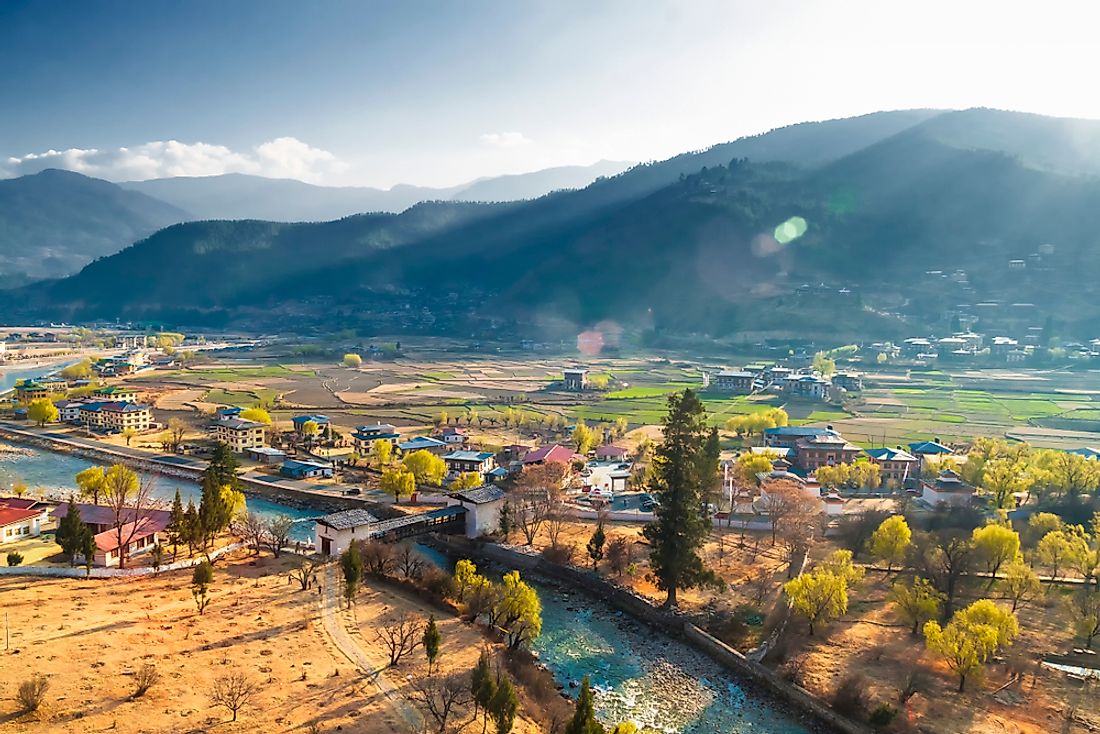What Are The Natural Resources Of Bhutan?

Officially known as the Kingdom of Bhutan, Bhutan is a country located in South Asia. The country has a total area of about 14,824 square miles and a population of around 797,765 people. Economically, the country has one of the smallest economies in the planet with a gross domestic product (GDP) of only $2.085 billion. As is the case with other countries in the world, natural resources play a crucial part in driving the economy of Bhutan. The country has a number of natural resources with the main ones being minerals (such as calcium carbide and marble), land for agriculture, electricity, forest cover, and tourist attractions.
Agriculture in Bhutan
Land resources play a crucial role in the economy of the country since agriculture is a major sector of the economy. In the past, agriculture was actually the biggest contributor to the nation’s GDP. For example, in 1985, the sector contributed about 55% of Bhutan’s GDP. In recent years, however, the contribution has gone down to only 33% in 2003. Despite the drop, agriculture is still a crucial sector to the economy since it provides a source of livelihood to about 80% of Bhutan’s population. Women are more involved in agriculture with 95% of the nation’s earning women working in the sector.
Bhutan is known for the production of two major crops, namely rice and maize. Of the two, maize makes up a larger portion of the nation’s cereal production (49%) while rice makes up 43%. Despite having a slightly lower production, rice is the staple crop of Bhutan. Other crops that the country grows include wheat, barley, oilseeds, and vegetables. Some of the challenges facing the sector include poor quality of soil in some areas, and irrigation challenges.
Forestry in Bhutan
Forest cover and natural vegetation have proven to be some of the most valuable resources of Bhutan in the 20th century. The extensive vegetation cover is because of the country’s location in the eastern region of the Himalayas, which is an area that receives high amounts of rain. The forests are composed of both evergreen and deciduous trees. The conservation of these forests is largely attributed to the small population of the country and the low levels of development. In addition, the rugged terrain of the country in most forested places makes it difficult to exploit the land. Established back in 1952, the Department of Forests and Park Services oversees the exploitation of this resource.
As of 1981, estimates place the forest cover of Bhutan at between 70 and 74% of the country’s total area. However, the forest cover went down vastly in 1991 as estimates placed the cover at between 60% and 64% of the country’s area. Other estimates placed the cover at closer to 50%. Regardless of the correct estimate, the forest industry generated around 15% of Bhutan’s GDP in the early stages of the 1990s. Most of the wood (80%) is for commercial use while the remainder is for other uses.
Tourism in Bhutan
Tourism in the country started back in 1974 when the government needed to come up with revenue. In order to achieve this goal, the government had no choice but to open the previously isolated country to tourists. In that year, only 287 visitors went to experience the country’s cultures and traditions. In the later stages of the 1980s, the sector had an annual revenue of at least $2 million. Over the years, the number increased to almost 3,000 visitors in 1992 before dramatically shooting to a little over 7,000 in 1999.
Initially, the sector was strictly under the control of the government as there were fears of the country’s unique environment being destroyed by visitors. For this reason, the government came up with restrictions on tourism with the restrictions being implemented by the Bhutan Tourism Corporation (BTC). However, the government privatized the BTC in October 1991 in order to increase tourism activity and investment. As a result of the privatization, the country now has more than 75 licensed firms working in the tourist sector. Despite the privatization, some restrictions still exist for visitors. For example, all visitors have to go there through a licensed tour operator but not individually. Most of the tourists come from countries like the Philippines, Canada, Germany, Thailand, and other countries. Visitors can visit a number of sites such as Thimphu (the capital city) and a Buddhist religious site called Taktshang.
Energy in Bhutan
Energy in the country is produced in high quantities because Bhutan has plenty of water resources and suitable terrain for the production of hydropower. For this reason, the government came up with the Five-Year Plans for the production of vast amounts of hydroelectric power. The plans have been implemented together with other countries like India. As of 2011, 60% of households in rural areas had electricity compared to 20% from 2003.
Some of the major power projects include the Chukha Hydropower Project, the Tala Hydropower Project, the Kurichhu Hydropower Project, and others. The Chukha Hydropower Project was the first major project in the country with its construction starting back in the 1970s. Before the construction of the Tala plant, the Chukha plant was the country’s major generator of income. The income was being generated through the export of electricity to parts of India such as West Bengal, Sikkim, Bihar, and others. Under the operation of Druk Green, the Chukha plant generated more than 30% of the country’s revenue between 2005 and 2006. Aside from the water, Bhutan has also harnessed power from other sources such as wind, the sun, and biogas.
Coal was also once used to produce vast amounts of energy for most of the population. In the 1980s, the country managed to produce coal that was almost equal to 1,000,000 tons of fuelwood every year for domestic use only. The estimated coal reserves were around 1.3 million tons although exploitation was not profitable due to difficulty and low quality of the coast.











